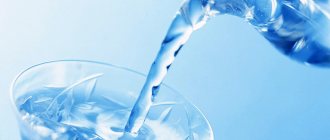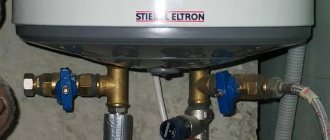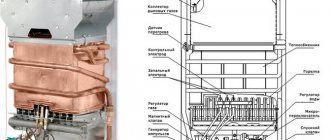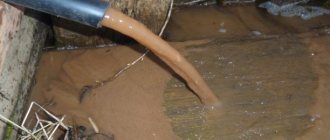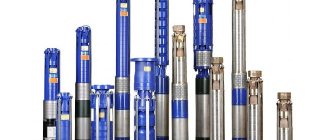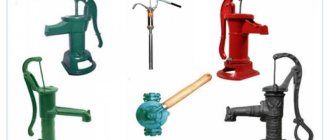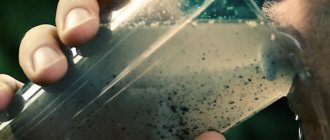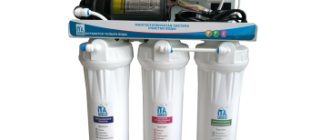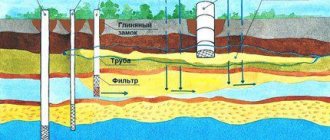It is almost impossible to obtain water suitable for cooking without special equipment. The water may contain sand particles and other contaminants, which are easy to remove. However, not every owner of a private house knows why rusty water comes from a well and how to get rid of this problem.
Rusty water comes from the well.
Collecting fluid for bacteriological examination
Analyzes for organoleptics and radiological impurities do not require such a thorough and careful approach to collecting material
- For this analysis, you need to purchase exclusively sterile containers (as sanitary standards say).
- If your well is not new, it should be treated with sodium hypochloride. The same applies to a new source.
- The tap from which water will be drawn must be burned or treated with medical alcohol.
- When taking liquid, you should not touch the neck of the bottle with your hands (it is better to wear sterile gloves), and the neck of the tank should not touch the tap.
- After collecting drinking water, we tightly screw the lid on and quickly send the water to the laboratory to determine its tank composition.
Proper water intake
You need to collect water directly under the neck and close the lid tightly.
To conduct analyzes of drinking water for quality and the presence of chemical impurities, it is necessary to strictly follow the recommendations that allow you to obtain the most accurate research result:
- The container or tank for water must be at least 2 liters, and it is advisable that it be a bottle of drinking water, but not one of compote, juice or other liquids.
- Never wash the bottle/tank with any detergents. It is enough to simply rinse the container with the water that you will take to the laboratory. We also rinse the lid.
- According to sanitary standards, drinking water should be taken from the source only after thorough drainage for 20-30 minutes. In this case, all the already settled water will be drained, and water will be supplied for analysis directly from the source.
- You need to collect water directly under the neck and close the lid tightly. In this case, it is better if the material is collected in a thin stream along the wall of the bottle or tank. In this case, chemical reactions in drinking water will be minimized, and the result of the study will be as accurate as possible.
- According to sanitary standards, water must be delivered to the laboratory no later than 2 hours after collecting the liquid.
Well problems
Iron can get into the well as a result of unscrupulous work by drillers. In this case, the following violations can be distinguished:
- Incorrect casing installation. According to the technology, the casing pipe should be inserted into the rocky horizon, but unscrupulous or unskilled performers can install it directly onto the reached hard rocks.
- Incomplete well completion. A sealed plastic water conduit must be installed in the steel casing pipe, which prevents the entry of groundwater and melt water.
If the technology is violated, groundwater and rock particles enter directly into the water supply system.
How to deal with an unscrupulous contractor? If iron gets into the water due to an incorrectly drilled well, the owner can order an independent examination, which will determine the shortcomings of the finished well.
With an expert opinion, you need to contact the company that drilled and equipped the well for a pre-trial settlement. If the examination reveals violations on the part of the manufacturer, the owner can also go to court.
How and with what to measure water levels
The uninterrupted operation of the pump and the supply of liquid depend on correct measurements. The difference between the 2 indicators exceeding 1.2 m forces us to look for the cause of the problem. A big difference can appear due to the entry of contaminated liquid from the soil into the system and the penetration of impurities with sediment into the well.
All measurements must be carried out qualitatively. Measuring the dynamic horizon is divided into several successive steps. In this case, the process will be noticeably simplified, and the measurement error will be smaller. It is recommended to determine levels on hot days that are not interrupted by precipitation. Water should not be used within 1 hour.
How indicators are measured:
- A small weight and nylon thread are required. The load is securely secured and lowered into the well to the very bottom.
- Then the thread is taken out and the length of its wet part is measured.
- A mark is placed on the border of the wet and dry area. It must be done in such a way that it does not disappear under the influence of liquid. You can use a permanent marker.
- The pump must then run for at least 60 minutes. The water horizon will definitely change.
- Then the thread with the load falls to the bottom again.
- The difference between the levels is then measured. To do this, a new mark is placed and the distance between the first and second values is measured. The second result is a dynamic level indicator.
Based on the data obtained, an analysis of the well's performance is carried out. The easiest way is to evaluate the values obtained over time using a computer program. In order for wells to operate normally, drilling technology must be followed. It must be produced in areas with a good aquifer.
What is the main difficulty of cleaning?
If the color changes, you need to do a water analysis. Taking into account the results obtained, a cleaning method is chosen. The main difficulty is the presence of several forms of iron, which complicate the neutralization process.
The following forms of iron exist:
- Trivalent. The insoluble compound is represented by fine particles of different sizes. Such impurities are removed using simple cartridge filters.
- Bivalent. To remove such a compound, preliminary oxidation is required. After this process is completed, iron becomes trivalent.
Iron can be formed when various organic substances react. Simple filters do not catch such compounds. The process of removing sediment and suspended matter includes several stages. To understand how to carry out all the work correctly, you need to determine the composition of the liquid.
Why does rusty water come out of the well?
“Brown” water often flows from a water well due to the penetration of trivalent (colloidal) soluble iron into it. It is this compound that, after settling, forms a sediment at the bottom of the container, coloring the water brown. In addition to ferric iron, water may contain a divalent form of the element, which is not capable of affecting transparency.
The reasons for the penetration of iron ions into the source are:
- activity of microorganisms;
- pipeline wear.
Whatever the reason for the deterioration of the quality of the liquid, it is necessary to eliminate it in order to obtain moisture that is safe for needs.
Why do you need iron removal equipment?
Initially, let’s refute the most common myth that supposedly a reddish liquid will flow in those areas where iron ore is abundant and work is underway to mine it. Underground groundwater, flowing through a layer of a chemical element, does not absorb harmful impurities and is supplied to the consumer in a state that complies with SES standards. The culprit is pipelines made of metal, which we inherited from the Soviet Union. Wear and tear of the system leads to the appearance of so-called iron bacteria, which multiply in large numbers on the inner walls of the pipes. They become a source of saturation of the flow with iron in the form of small particles, in rare cases (almost never) with scale.
Normal water indicators
Water from individual sources and wells in laboratories is evaluated for such chemical elements and their indicators. See table.
Organoleptics (sanitary standards for an individual well):
| № | Name | Units | Sanitary standards |
| 1 | Smell | points | |
| 2 | Chroma | degrees | |
| 3 | Turbidity | 1Nok=0.58 mg/dm3 | |
| 4 | Taste and smack | points |
Table of chemical indicators
| number | Chemical element name | Unit | norm |
| 1 | Hydrogen | PH units | 6,5-8,5 |
| 2 | Iron | Mg/dm3 | |
| 3 | Overall hardness | Mol/dm3 | |
| 4 | Manganese | Mg/dm3 | |
| 5 | Sulfates | Mgdm3 | |
| 6 | Dry residue | Mg/dm3 | |
| 7 | Residual free chlorine | Mg/dm3 | |
| 8 | Chloride | Mgdm3 | |
| 9 | Residual bound chlorine | Mg/dm3 | |
| 10 | Ammonium | Mg/dm3 | |
| 11 | Nitrates | Mg/dm3 | |
| 12 | Nitrites | ||
| 13 | Fluorides |
https://youtube.com/watch?v=eEatnR_FMLk
What water indicators are most important for humans?
When there is an understanding of the need for testing, questions arise: what exactly is contained in our water, where we should go, what impurities we should get rid of first. Here we are faced with the choice of the organization conducting the analysis, with its competence and integrity.
Unfortunately, there are companies selling filters and treatment plants that manipulate the results to push an inexperienced summer resident to purchase expensive equipment. If you don’t have time to study SanPiN and other regulatory documents, look at just two tables:
This is interesting: The roof of the balcony of the top floor is leaking - we outline it point by point
Gravity aeration water treatment systems
The second type of aeration system is non-pressure. It has a large container in which water settles. The volume of the container is from 600 liters, but in general it depends on the water consumption: no more than 50-60% of the available volume should be consumed so that the sediment remains at the bottom.
Water is supplied to the container directly from the well. The water level can be controlled by sensors - lower and upper levels or, as in the photo, by a float switch of the well pump. To protect the system from overfilling, a water discharge pipe is made just above the critical level. It can go into the drainage or sewer systems
It is important that there are some visual sensors that there is too much water in the tank
Gravity aeration system for purifying water from a well from iron, manganese, other impurities and dissolved gases
This system works like this: Water is drawn into the tank to the required level, after which the pump is turned off. To purify the water, a compressor is turned on (possibly powerful for aquariums), which supplies air to the tank. It is distributed through a divider, which is located approximately halfway deep.
To ensure constant pressure in the system, water from the tank can be pumped out using a pumping station. Water is taken from the lower third, but not from the very bottom (through Tap 1): the cleanest water accumulates here. It enters the pumping station through Faucet 3 and from there, through a tee and Faucet 5, enters the system.
The diagram above also provides for a water purification system from a well. In this case, Faucet 2 and Faucet 5 are closed, Faucet 2 and Faucet 4 are opened. Sediment from the bottom with this position of the shut-off elements is drained into the sewer or drainage system. After the sediment has been removed, you need to drain some more clean water to thoroughly rinse all the pipes. Only when clean water flows into the sewer can all taps be returned to their original position.
Another way to organize water purification from a well
Installation of hot water equipment
This question is not relevant for owners of private houses that are not connected to the main line, but take moisture from their own well. We will talk about apartment owners where there are several supply systems. A filter unit is installed on the main pipe. But to prepare food and quench your thirst, this is not enough; you will have to install a purification system, which is installed under the kitchen sink. Clear space of all unnecessary things, as you need to have enough space to replace cartridges or clean the structure.
SF-mix manual up to 0.8 m3/h
AMETHYST - 02 M up to 2 cubic meters/day.
Aeration unit AS-1054 VO-90
Sanitary standards for drinking water quality indicators
The quality of drinking water is analyzed based on the standards of indicators in accordance with the requirements of regulatory documents of states.
The table presents the standards for the main quality indicators according to the sanitary standards of SanPiN of the Russian Federation, specified in column 3 - SanPiN 2.1.4.1074-01 “Hygienic requirements for water quality of centralized drinking water supply systems” and column 4 - SanPiN 2.1.4.1175-02 “Hygienic requirements for water quality of non-centralized water supply. Sanitary protection of sources."
It is by these indicators that you should check the quality of water from your source and assess the need to install additional equipment for water purification.
For comparison, the standards of the World Health Organization (WHO) are given.
How to choose a rust filter
The correct choice of a rust filter for water supply depends on taking into account the following parameters:
- daily water consumption;
- required level of cleaning.
Laboratory testing of water samples will determine iron saturation, the presence of harmful contaminants, and the level of contamination. Based on the results of the analysis, a main filter for rust is selected, followed by a filter for fine water purification.
Specifics of analysis depending on well depth
Surface water
The cleanliness of the surface layer depends on the landscape and environmental conditions. Its composition is affected by climate change and chemical emissions. The upper aquifer may contain pesticides, fertilizers, human or animal waste products, nitrates, and heavy metal salts. This layer is most vulnerable to pollutants.
Up to 30 meters
A sand well is drilled to this depth, water is extracted from the upper sand layer. When drilling such a source, a filter is needed to clean the liquid from sand impurities. For its further use in food, additional cleaning will be required, because... Toxins, sediments, and industrial emissions can penetrate into surface aquifers.
30-70 meters
Limestone wells are drilled to this depth. Water obtained in this way is called artesian. It has a balanced chemical composition and is suitable for drinking, but may contain carbonic acid, salts, and be highly oxidizable.
Water analysis depending on the depth of the well.
100 meters or more
The source, located at a depth of more than 100 m, is considered safe for water intake - the liquid in it is filtered by several layers of sand and clay, but the proximity to deposits of table salt ensures a high level of mineralization, and the absence of air contributes to the development of sulfur bacteria, which add a rancid smell. Drilling a well to a depth of more than 100 m requires obtaining a license, which requires expertise.
This is interesting: Modern facade materials for exterior decoration of a house: we describe it from all sides
Types and features of connections
If the water becomes reddish due to the presence of metallic fractions, this can be determined by external signs. When assessing, it is important to consider:
The more foreign inclusions, the worse the water quality (the upper permissible limit is 2 mg/l).
Rust can be distinguished from clay and other compounds by their organoleptic properties - iron gives water a characteristic metallic taste, and its high concentration also affects the smell.
Instructions on how to do analysis in the laboratory
For the necessary research, it is better to contact large companies that have their own laboratories. Find out in advance the list of proposed tests and enter into an agreement that specifies:
- the type of document to be issued;
- all tests performed;
- cost of work;
- deadlines.
Water collection and delivery
In most cases, a laboratory specialist takes a sample for examination. This is how you do it yourself:
- Prepare a container with a capacity of 1.5–2 liters, preferably a special one; a bottle of sweet, carbonated and alcoholic drinks will not work.
- If a sample is taken from a tap, allow the water to drain for 10 minutes.
- Rinse the container from the source of the intake and, under low pressure, fill it to the brim, keeping it at a distance of 1–2 cm from the tap.
- Close the lid tightly so that there is no room for air.
The container is placed in a dark bag to protect it from sunlight during transportation, and delivered to the laboratory within 2–3 hours. For radiological analysis, 10 liters of water are required.
Price
Average prices for research:
- microbiological – 1–1.8 thousand rubles;
- standard – 3–4 thousand rubles;
- extended - up to 4.5–6 thousand rubles;
- full – 7–9 thousand rubles.
Services for sampling by a specialist and preservation (if necessary) will cost 1.5–2 thousand rubles, and the provision of consumables and instructions for preserving samples for testing for hydrogen sulfide will cost 0.4–0.6 thousand rubles. Radiological costs 10.5–11 thousand rubles. and takes longer than others - up to 2 weeks.
Decoding the results
The protocol states:
- The amount of identified substances and their maximum permissible concentration (MPC), specified in regulatory documents (SanPiN 2.1.4.1074-01, WHO recommendations).
- Hazard classes of elements (1K – extremely dangerous, 2K – highly dangerous; 3K – dangerous, 4K – moderately dangerous).
- Toxicity. Sanitary-toxicological indicators are designated “s-t”, organoleptic indicators - depending on the ability of the element to change the smell, color, taste of water, cause foaming or opalescence, respectively, by the first letters of the words defining these meanings (“zap”, “okr”, “privk” etc.).
Based on the results of the examination, equipment is selected to improve water quality.
To remove mechanical contaminants, you need a mechanical cleaning filter, a housing filter with a replaceable cartridge, and for high concentrations, a column-type filter with a control valve and automatic washing.
Ultraviolet submersible sterilizers (UV lamps) protect against viruses and bacteria, which operate in short wavelength mode and destroy microorganisms at the molecular level without affecting the natural properties of water. For a country house, it is enough to have a sterilizer with a capacity of 0.5–2 m³/h.
The lamps have durable fluoroplastic bases. For wells serving cottage villages, sanatoriums and enterprises, industrial sterilizers with a capacity of 8–60 m³/h are required.
The stationary filter removes chlorine, heavy metals, iron, petroleum products, mechanical particles and other unwanted impurities, and reduces hardness. The water is saturated with beneficial calcium in the form of aragonite. A separate tap (push-button or valve) for clean liquid is installed at the kitchen sink.
To add the necessary components and maintain their constant concentration, a dosing complex is used, which consists of a dosing pump, a pulse counter, suction and injection valves, and a container for dosing the reagent.
The water meter gives pulse signals, according to which the pump injects the reagent in proportion to the programmed value.
To remove iron compounds, reagent-free filters are installed, based on the principle of oxidation of iron with oxygen from a dissolved form to a solid state, followed by separation of the resulting suspension.
Carbon filters will help reduce the hydrogen sulfide content in a well and well; cleaning occurs by adsorption.
Disinfectants
Disinfection of water in a well is carried out with special preparations with disinfectant and antibacterial properties. Well products must destroy pathogenic microflora, quickly erode or disintegrate into components that are safe for people. There are 9 methods that can be used at home.
White
An inexpensive, simple option is used to disinfect a well. A chlorine-based chemical is suitable for a moderately neglected well. Take 1 liter of the drug per ring of the structure. The product is poured over the walls from the bucket, the surface is thoroughly smeared with a brush on a long pole. If you have a garden sprayer, it is easier to spray the disinfectant liquid.
The well is covered with thick cloth or polyethylene, left for a day in cold weather, and for 10 hours in warm weather. Ultraviolet radiation should not enter the well, otherwise the bleach will disintegrate under the influence of the sun. The absence of the smell of "Whiteness" in the mine indicates the destruction of the chemical. To disinfect the structure, the procedure must be repeated.
Bleach for disinfection Source remontkit.ru
After disinfection of the well is completed, the walls are washed with chlorinated liquid, then with clean liquid. The water is pumped out until the smell of the drug disappears. The moisture in the well cannot be used for drinking for 7-10 days.
Lime
One percent chlorine comes in the form of a white powder. The product in plastic bags of various packaging can be purchased at hardware or construction stores. To prepare the essence, 10 g of the substance is dissolved in 1 liter of pure liquid. To disinfect water in a well, take 400 ml of the prepared solution per 1 m3 of moisture in the well.
Chlorine for wells Source plesneveet.ru
If the structure is small, then the chemical liquid is poured into the source along the walls. A large shaft is treated with a special stick with a brush or sponge at the end. Manipulations are carried out for 10 minutes, after which the well is covered from the sun with a film (thick cloth). In summer, 6 hours of disinfection is enough; in autumn or early spring, the lime is left for 12-24.
Upon completion of the procedure, the chemical solution is thoroughly washed off the walls of the well. The moisture is pumped out until the chlorine odor disappears. As with Belizna, the liquid will become suitable for drinking after 10 days.
How to clear sand from well water
Removal of sand or particles of clay, silt, and other large particles occurs on a filter lowered into the well. This is done using simple mechanical filters - plate or sand - and this stage is called the coarse cleaning stage.
If there is a lot of suspended matter, one filter is not enough: it will quickly become clogged. It is more practical to install a system with cells of different sizes. For example, water from a well falls on a filter that captures particles up to 100 microns in size, then a filter with a purification degree of up to 20 microns is installed. They will remove almost all mechanical impurities.
Filter types
Filters for coarse water purification from a well are: mesh, cassette (cartridge) or backfill. Mesh ones are most often installed in the well itself. They are a hollow pipe of slightly smaller diameter than the wellbore. Holes are drilled or slots are made in the walls of the pipe (the shape of the holes depends on the soil), wire is wound on top, and a mesh is placed over it. The mesh cell is selected depending on the type of soil in the aquifer: it must retain the bulk of contaminants and at the same time not become clogged. At this stage, the largest impurities are retained, which can also damage the pump. But some solid particles still rise to the surface. They are removed during further water purification.
Mesh filters are installed in wells. They filter out sand and other coarse impurities
Sometimes it is not possible to install a filter in a well. Then all cleaning is transferred to the surface. In this case, cassette or bed filters are used to purify water from a well. Cassette ones have a replaceable cartridge - a membrane system, crushed charcoal, etc. on which sand and other large contaminants settle.
From time to time, cartridges become clogged and need to be replaced. The frequency depends on the degree of water contamination and the intensity of its use. Sometimes one cartridge gets clogged quickly. In this case, it makes sense to install two filters with different degrees of purification. For example, the first one retains particles up to 100 microns, and the one behind it up to 20 microns. This way the water will be clean and the cartridges will have to be changed less often.
One of the types of cartridges for filtering water in a private home
In bulk filters, bulk filter material is poured into a container - sand, crushed shell, special filtrates (for example, BIRM). The simplest mechanical filter is a barrel of sand with a washing function. One caveat: if there is a large amount of dissolved iron, it is preferable to add a special filtrate; it is also a catalyst that oxidizes dissolved iron and manganese, causing them to precipitate.
Depending on the particle size of the backfill of such a filter, quite small particles may be retained. Sometimes two such filters are installed in a row, only with different fillings - first the water enters the one where the filtrate is large, then with a smaller filling. Bulk filters for purifying water from a well are good because they require replacing the backfill approximately every three years. And this is how they differ from plate filters, the filter of which must be changed much more often: sometimes once a month, sometimes once every three to six.
But for cleaning with a backfill filter to be effective, they require periodic washing of the filtrate. This usually happens by turning off some taps and opening others. In this case, the water flows in the other direction, washing away the bulk of the accumulated sediment.
The principle of water purification in a backfill filter
For an example of assembling two sequential filters for purifying water from a well from coarse impurities, see the video.
You can read how to make a bailer for cleaning a well here.
Harm to household appliances
If you open the tap in the morning and see a reddish liquid with a characteristic odor, then do not rush to pour it into the kettle or cook food with it. This can cause irreparable damage not only to your health, but also to all the items you use every day in your home.
Rust causes the greatest damage to various devices during their operation:
- The lumen of pipes narrows due to deposits of Ferrum oxide, which can eventually lead to rupture of metal products and flooding of the home.
- Heating elements in dishwashers and washing machines fail.
- The pressure in geysers decreases.
- Shower heads and often kitchen and bath faucets become clogged with scale.
- Covered with brown spots and plumbing deposits. You have to use a lot of effort to get rid of plaque.
Ultimately, if you do not install anti-rust water filters in your apartment in a timely manner, then repairing the equipment will cost you a hefty sum.
Traditional methods for purifying water from lime
The first group of methods that have found widespread use among people includes the following:
Advocacy
The liquid must be poured into a container, left overnight, then drained 2/3 into another clean container. The remaining 1/3 contains all kinds of impurities (sand, lime, iron)
It is important that this option can also be used to remove impurities from tap water, since all the chlorine will evaporate overnight. However, this method requires a lot of time, besides, you will have to constantly pour water, and it is difficult to remove impurities from a large volume
Boiling
The second simplest and most common purification method is boiling. To achieve the result, the liquid must be boiled for 10-15 minutes. During this time, harmful microorganisms will disappear, and lime will precipitate. The disadvantages include the difficulty of removing scale, and also, as in the case of settling, low productivity.
Freezing
An enamel pan filled with water should be placed in the freezer. After half the water has frozen, remove the resulting ice. He is the goal. Dirt should accumulate in the middle, pour boiling water into this place, the dirt will melt and go away. The remaining ice is perfectly clean, melt it and use the water. True, such water has one drawback - it contains a minimum of useful substances. To enrich with salts, use mineral water, adding 100 ml in proportion. mineral water for 1 liter. melt water.
Activated carbon cleaning
Manufacturers of household filters actively use activated carbon. Five tablets should be wrapped in gauze and placed in a pan overnight. Charcoal will not only cleanse the impurities contained in hard water, but also get rid of foreign odors.
This is interesting: Connecting a Mercury 201 meter: short and clear
For modest needs: pitcher filter
- What's good: does not require installation
- What's bad: low performance
If your water is not of terrible quality and you need a small volume for cooking and drinking, you can try using a simple jug-type filter . Such models can have both simple activated carbon cartridges and complex ones for complete cleaning. The capacity is small, so for a large family it is better to choose an option with a larger volume: so that there is always water.
For example, this jug from Aquaphor holds 4.2 liters:
For dacha conditions, it is usually important to remove iron (it is what gives the water a “rusty” tint. Pay attention to filters with several stages of purification, including softening and especially iron removal. For example, this Geyser with a 4-liter jug:
Boiling and mechanical filtration
An example of the operation of backfill filters for water purification
As you know, when lime water is boiled, calcium salts accumulate in the form of scale on the bottom and walls of the container. This is the simplest, easiest and most accessible method for doing it yourself. However, a lot of water cannot be purified this way. The disadvantages of this cleaning method include low efficiency and difficulties in removing scale.
Most often, mechanical filtration is used to purify water from a well or private well. It is suitable for removing particles as small as 5 microns. For the event you will need a special filter for lime water. The simplest option is to use backfill filter layers with automatic washing. In such devices, different materials can be used as backfill: activated carbon, quartz sand, shungite.
The disadvantages of bed filters include the following:
- the method is effective only for removing particles larger than 20 microns;
- the design of the filter device is too bulky (on average 1.6 m x 26 cm);
- high price.
Example of a disk filter with a replaceable cartridge
Replaceable filtration cartridges have become a good alternative to these devices. They are made from foamed polypropylene. Such devices guarantee high quality cleaning – from 5 microns. Such cartridges can be installed in any filtration units or multi-cartridge devices. The only drawback is the need to change cartridges frequently.
To purify water from a well or well in a volume of 4 to 800 m³/h, you can use disk filters with automatic flushing. They are suitable for particles ranging in size from 5 to 500 microns. The main disadvantages of such devices:
- high cost;
- the need to provide the required water pressure for flushing.
The advantages include:
- small size of the unit;
- complete automation of the process;
- high degree of efficiency.
Why is high iron levels dangerous?
Rust in water can cause the following diseases:
- allergic reactions in the form of skin itching and rash;
- dysfunction of the gastrointestinal tract.
In addition to the impact on human health, corrosion and clogging of water pipes negatively affect the operation of washing machines, dishwashers, faucets and other plumbing fixtures. Therefore, it is important to use methods of protection against corrosion, and if the color of the water changes, test for iron content.
How to purify water
You can reduce the concentration of iron compounds yourself in several ways. The cleaning method depends on the volume of liquid consumed and how many impurities it contains.
Advocacy
The easiest way to clean a resource extracted from a well. An additional water reservoir is built, designed for the volume of expected liquid consumption per day, and sedimentation occurs in it.
pros
- A simple method that does not require large expenses
- There is always a supply of clean water.
- Installing the tank in the attic will create a gravity flow. And it will rid the water of hydrogen sulfide.
Minuses
- Cleaning is not complete
- The container must be cleaned periodically, which is not very convenient, since it requires disconnection from the system.
- Carefully monitor the amount of liquid consumed.
Aeration
The deposited sediment at the outlet after cleaning is captured by mechanical filters.
- Gravity - Water comes into contact with oxygen to the maximum, this happens due to atomization. Sprayers move liquid into a reservoir. For more productive cleaning, if necessary, a compressor is installed in the container.
- Pressure type of cleaning - involves the entry of liquid into the system under high pressure. Working in parallel, the pressure and the compressor create bubbling and foaming, which allows the liquid to come into contact with air as much as possible.
In addition to removing iron, the aeration method gets rid of hydrogen sulfide.
- The main advantage of this cleaning is environmental friendliness. The process eliminates the use of reagents.
- Flaws. There is still a certain amount of iron left in the water. The operation of the system depends on the availability of electricity. The container and filters must be cleaned periodically.
Ozonation
The process is effective but labor-intensive.
The use of chlorine is becoming a thing of the past. After cleaning using this reagent, it partially remains in the liquid and is harmful to humans and the environment.
Ozonation is considered to be the most reliable method, the effectiveness of which is created by the action of ozone and its derivatives on the impurities contained in water.
Organic iron is removed from a liquid by cumulative action. The process of purifying fluid extracted from a well by ozonation is quite complex. Requires installation of expensive equipment. An accurate calculation is required for productive work; it is very difficult to do it yourself (you need to calculate how much ozone is needed and the time of its exposure to water in accordance with the amount and type of impurities it contains).
Ion exchange
This cleaning is carried out using filters containing resin and free ions. As the water passes through the filter, the sodium ions exchange places with the iron ions. Therefore, the method is called ion exchange.
When the filter has used up all its resources, they must be restored.
Reverse osmosis
Purification of water from iron and impurities is done with a filter containing a membrane; it is this membrane that carries out filtration at the molecular level. The reverse osmosis method of iron removal is considered the most productive. Dissolved particles are removed. To improve the quality of filtration and stop the failure of the membrane, it is necessary to pre-clean the water with mechanical filters.
Reverse osmosis completely purifies water from all types of contaminants. The method is the most effective, but very expensive.
Microfiltration, nano- and ultra-membranes work similarly to reverse osmosis.
Introduction of Reactants and Catalysts
The use of chemical reagents for deferrization of liquids is mainly used in industry. Additional purification of the liquid is necessary. Chemical compounds must be removed. The principle is similar for all purification systems - a chemical reaction occurs between the iron and the reagent, resulting in the formation of a precipitate.
Catalysts are used together with aerated water or with the use of reagents for the oxidation of iron.
The catalytic method of iron removal from water occurs using filters containing material with catalytic properties. Water passes through porous fillers, which provide high-quality cleaning.
Popular makes and models
In the KVANTA+ store in Tyumen you can buy filters from leading manufacturers. The company offers a wide selection of models at affordable prices.
"Aquaphor"
The Russian company produces many cartridges and filters for household use. Particularly popular is the Aquaboss-1-02 device, which is distinguished by its ease of use and budget price. If the module fails, you can find an inexpensive replacement.
Aquaphor produces many cartridges and filters.
Buy
"Geyser"
The company's product range includes filters of different price segments. The Geyser 1PF model provides effective water purification and is intended to protect boilers and washing machines from scale.
Buy
"Barrier"
"Barrier Smart Opti-Lite" is an inexpensive Russian-made jug with a stylish body design and support for up to 8 types of cassettes. 1 filter element can process up to 350 liters of liquid.
Barrier is a jug with a stylish design.
Buy
BWT
The Austrian company BWT produces the Protector mini 1/2 CR model. This filter is compact and has a capacity of up to 1.6 cubic meters per hour.
Honeywell
The FF06 1/2AAM device from the German company Honeywell belongs to the mechanical category. The brass body can withstand water temperatures up to 70°C.
Honeywell - water purification device.
Buy
Atoll
Atoll's production facilities are located in Russia and the USA. The Atoll A-550m STD/a-560Em model is suitable for a family of 4-5 people. The complex device supports 5-stage cleaning.
Buy
Atlas Filtri
In the catalog of the Italian company Atlas Filtri, the Senior Plus Hot 3P-AFP SX ½ model is in particular demand. The mechanical cartridge-type device is able to cope with any type of suspended particles.
Atlas Filtri is an Italian filter.
Organic
The Ukrainian company produces inexpensive drinking filters with a simple design and operating principle. The Organic Master series is aimed at basic liquid purification, while it can be converted into a reverse osmosis system.
Aquafilter
The Polish brand Aquafilter gained popularity after the release of the FHHOT34-HPR-S model. The filter device contains a glass and a lid. The cleaning cartridge must be purchased separately.
Aquafilter is a popular Polish brand.
EcoWater Systems
The eXPERT series deferrizers from EcoWater Systems are advanced systems for processing large volumes of liquid. The Oxy 700+ model allows you to get rid of manganese, hydrogen sulfide and iron in water, which are often present in artesian wells.
Well water testing
Sampling frequency
According to SanPiN norms, clause 2.2.3 for surface layers, monthly studies are provided for legal entities. Owners of private wells do not need to contact specialists so often without serious reasons. For wells, the document provides for tests to be done every quarter. New sources are tested at the beginning of operation and immediately after installation of the treatment system. If you get good results at the end of each season, in the future it is enough to monitor the point once a year. To collect water, you must follow certain rules, otherwise the final data will be unreliable.
By doing a quick analysis, you will get a sufficient result if your well is deeper than one hundred meters (artesian) and there are no changes in the properties of the water. In other cases, it is worth doing a detailed analysis, especially of the upper soil layers.
Objectives of laboratory research
1. Making a decision on the possibility of using this water as drinking water. This aspect is especially relevant when purchasing a cottage or land for a summer residence. 2. Obtaining results based on chemical and bacteriological characteristics to select a filtration method to the desired parameters. 3. Assessment of the operation of treatment systems, their effectiveness. 4. Parameter monitoring.
When to do the analysis
- Drilling a new well.
- Decrease in pressure, level, quality for unknown reasons.
- Neighborhood with industrial or agricultural facilities.
- Emergency situations: penetration of waste and sewer liquids, release of excess toxic gases into the air near the site.
Preventive measures
Complete disinfection and repair of structures is carried out once every 5-7 years. To minimize costs and prevent water contamination, regular light cleaning and disinfection are needed. If the well is used constantly, then one procedure per year is sufficient. At summer cottages, activities are carried out at the beginning and end of the season.
After cleaning the well Source yandex.ua
To prevent rain and wastewater from entering the well, a clay castle is installed around the structure. The device acts as a water seal, suitable for areas with a risk of floods or swamps. The element protects concrete rings from clogging with soil and upper groundwater.
To create a castle, a trench is dug around the well, the depth of which is between 1.7-2 m and a width of up to 1 m. The ditch is filled with dense (“greasy”) clay with a high degree of viscosity. The wet substance is compacted around the concrete rings. To allow water to drain, the upper part of the structure is installed above the ground.
A properly selected bottom filter independently copes with the disinfection of moisture in the well. The device purifies liquid by chemical and physical methods. Zeolite is added along with traditional quartz sand and river pebbles. Jadeite (bath stone) removes heavy metals and prevents the movement of materials in the lower layer.
If the well is located on quicksand or water flows under high pressure, then a bottom shield is needed. The iron alloy mesh breaks down due to corrosion and substances penetrate into the drinking moisture, which can affect the taste or color. Aspen structures do not rot, do not change the aroma and additionally disinfect the liquid.
Well cleaning Source yandex.ua
The cap not only has a decorative function, but also prevents contamination of the well. The water in a closed well does not bloom, leaves, dust or dead animals (insects) do not get inside. The structure in the form of a cover or canopy can be assembled from wood, stone or siding, adapting it to the landscape design.
Expert advice
To ensure that the parameters of the dynamic and statistical level do not change critically for the worse over time, it is necessary to periodically carry out maintenance. To do this, water must be regularly collected for laboratory analysis. This is especially necessary if there is an unpleasant odor or color change.
Also, experts do not advise developing a well on your own. It is better if it is dug by professional workers. In this case, a passport will be issued containing all the necessary data about her condition. Each company issues a passport according to its own model, but the main columns of all executors are the same.
When operating a well, it is necessary to use proper equipment. In this case, its uninterrupted operation for a long time is possible.
It is important to remember that repairing wells comes with costs and some risks. The ultimate goal of all manipulations related to level measurements is to provide the area with clean and fresh water of good quality
Criteria for choosing wisely
There is no point in saving money on a country water filter. Cheap equipment, at best, will not provide the desired degree of purification, and at worst, it will add foreign impurities.
When choosing a device, pay attention to the following parameters:
- Number of cleaning stages - the more modules, the better the output result.
- Productivity – jug-type models can satisfy the needs of one or two households. For a large family, it is better to purchase stationary models.
- Features of filtration - the device should be selected individually, focusing on the composition of the water.
Since the filter is constantly in contact with the aquatic environment, all its elements must be made of materials that are resistant to its negative effects.
For stationary models connected to water supply, the key selection criterion is durable and durable materials.
Some models may be equipped with mineralizers. The usefulness of these modules has not been proven by scientific research. Therefore, use them or not - decide for yourself.



